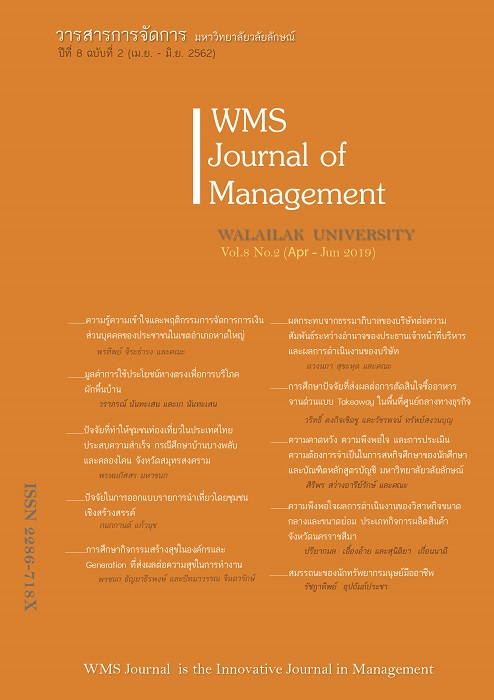The Moderating Effect of Corporate Governance on Relationship between CEO Power and Firm Performance
Main Article Content
Abstract
The purpose of this study is to study the effect of corporate governance on the relationship between CEO power and firm performance. The sample has been collected for 7 years, from 2010 to 2016. This study uses the Multiple Regression Analysis to test the relationship between CEO power and firm performance. In addition, this study tests the moderation effect of corporate governance on the relationship between CEO power and firm performance.
The empirical study found that CEO power has statistical significance effect on firm performance. To test the moderating effect, this study found that the effect of the interaction between CEO power and corporate governance is not significant to the firm performance. Thus, we tested the sub-group analysis to see the effect of corporate governance on those relationship. This empirical study shows an interesting result. When companies have high CG score, the relationship between CEO power and firm performance is not significant. In contrast, when companies have low CG score, the relationship between CEO power and firm performance shows a negative effect to firm performance. This study implied that the companies with low level of corporate governance will have an Agency problem. CEOs who hold the position of the chairman of the board will have high power level thus they will be difficult to be monitored from the board. As a result, they can take advantage for their own benefit instead of for the shareholders. Finally, the firm performance declined.
Article Details
References
Baron, R., & Kenny, D. (1986). The moderator-mediator variable distinction in social psychological research: Conceptual, strategic, and statistical considerations. Journal of Personality and Social Psychology, 51(6), 1173-1182.
Chen, H. (2014). CEO duality and firm performance: an empirical study of EU listed firms. 3rd IBA Bachelor Thesis Conference, University of Twente.
Christensen, J., Kent, P., & Stewart, J. (2010). Corporate governance and company performance in Australia. Australian Accounting Review, 20(4), 372-386.
Combs, J., Ketchen, D., Perryman, A., & Donahue, M. (2007). The moderating effect of CEO power on the board composition-firm performance relationship. Journal of Management Studies, 44(8), 1299-1323.
Davis, J. H., Schoorman, F. D., & Donaldson, L. (1997). Toward a stewardship theory of management. Academy of Management Review, 22, 20-47.
Duru, A., Iyengar, R., & Zampelli, E. (2016). The dynamic relationship between CEO duality and firm performance: The moderating role of board independence. Journal of Business Research, 69(10), 4269-4277.
Elsayed, K. (2007). Does CEO duality really affect corporate performance? Corporate Governance: An International Review, 15, 1203–1214.
Finkelstein, S. (1992). Power in top management teams: Dimensions, measurement, and validation. Academy of Management Journal, 35(3), 505-538.
Fuzi, S., Halim, S., & Julizaerma, M. (2016). Board independence and firm performance. Procedia Economics and Finance, 37, 460-465.
Gompers, P., Ishii, J., & Metrick, A. (2003). Corporate governance and equity prices. The Quarterly Journal of Economics, 118(1), 107-155.
Intintoli, V. J., Zhang, A., & Davidson, W. N. (2014). The impact of CEO turnover on firm performance around interim successions. Journal of Management & Governance, 18(2), 541-587.
Jensen, M. C., & Meckling W. J. (1976). Theory of the firm: managerial behavior, agency costs and ownership structure, Journal of Financial Economics, 3(4), 305-360.
Jermias, J., & Gani, L. (2014). The impact of board capital and board characteristics on firm performance. The British Accounting Review, 46(2), 135-153.
Jiamsakul, S. (2007). The Performance Effects of Transparency and Disclosure, and Board of Directors: The Case of SET100 Thailand. Doctoral dissertation, The Joint Doctoral Program in Business Administration, Chulalongkorn University, Thammasat University, and Nation Institute of Development Administration.
Kaohoon. (2017). Business Kaohoon. Retrieved from https://www.kaohoon.com/content/202402.
Kaohoon. (2018). Business Kaohoon. Retrieved from https://www.kaohoon.com/content/219958.
Kim, K.-H., Al-Shammari, H. A., Kim, B., & Lee, S.-H. (2009). CEO duality leadership and corporate diversification behavior. Journal of Business Research, 62(11), 1173-1180.
Lam, T., & Lee, S. (2008). CEO duality and firm performance: Evidence from Hong Kong. Corporate Governance, 8(3), 299-316.
Liu, Y., & Jiraporn, P. (2010). The effect of CEO power on bond ratings and yields. Journal of Empirical Finance, 17, 744–762.
McColgan, P. (2001). Agency theory and corporate governance: “A review of the literature from a UK perspective.” Retrieved from https://pdfs.semanticscholar.org/79c5/2954af851c95a27cb1fb702c23feaae86ca1.pdf.
Mohammadi, A., Basir. N. O., & Lööf, H. (2015). CEO Duality and Firm Performance Revisited. Retrieved from https://static.sys.kth.se/itm/wp/cesis/cesiswp400.pdf.
Peni, E. (2014). CEO and chairperson characteristics and firm performance. Journal of Management & Governance, 18(1), 185-205.
Pongpanpattana, J. (2015). Mechanism of good governance and firm performance: an empirical evidence from Thai-listed firms. Journal of Modern Management Science, 8(1), 67-77.
PTT public company limited. (2018). Good corporate governance. Retrieved from http://www.pttplc.com/th/about/pages/corporate-governance.aspx.
Songsuk, P. (2014). kānprayukchai SPSS wikhro̜ khō̜mūn ngānwičhai. [Application of SPSS data analysis] (4th ed.). Maha Sarakham, Thailand: Maha Sarakham Publisher.
Sharifah F.S.F., Syahrina A.A.H., & Julizaerma M.K. (2015). Board independence and firm performance. Procedia Economics and Finance, 37, 460-465.
Jiamsakul, S. (2007). The Performance Effects of Transparency and Disclosure, and Board of Directors: The Case of SET100 Thailand. Doctoral dissertation, The Joint Doctoral Program in Business Administration, Chulalongkorn University, Thammasat University, and Nation Institute of Development Administration.
Tang, J. (2017). CEO duality and firm performance: The moderating roles of other executives and block holding outside directors. European Management Journal, 35(3), 362-372.
Thaipublica. (2018). Group Lease: Responsibility of the audit committee. Retrieved from https://thaipublica.org/2017/11/pises12/.
The Securities and Exchange Commission. (2018). Good corporate governance. Retrieved from http://www.sec.or.th/TH/RaisingFunds/EquityDebt/Pages/linkLaws_Regulations/CorporateGovernanceCG.aspx.
Ujunwa, A., Salami, P. O., & Umar A. H. (2013). CEO duality and firm performance: an integration of Institutional perceptive with Agency Theory. International Journal of Economics and Management Engineering, 7(1), 180-186.


